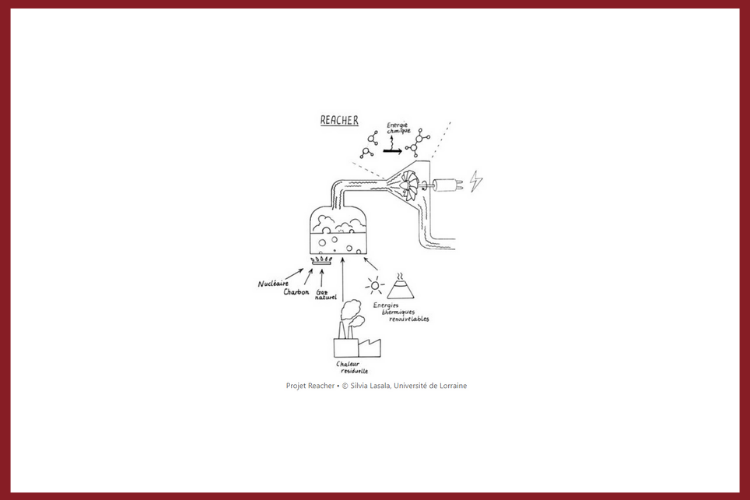Silvia Lasala, a researcher at the University of Lorraine, has been awarded a European grant for her REACHER project. She is one of the 397 winners of the ERC Starting Grant 2021. Her research focuses on a promising energy conversion.
“No one has ever designed a reaction with the thermochemical characteristics that we want to implement. This is a first! ” This is a real challenge for Silvia Lasala, senior lecturer at the University of Lorraine, researcher at LRPG and teacher at ENSIC.
And that motivates her even more. She has just been awarded 1.5 million euros for a high-risk, but also high-potential project. A European grant awarded by the ERC (European Research Council) as part of the Starting Grant 2021. This scheme favors the pioneers, those who will venture far enough to potentially make a major discovery while also taking a big risk. Silvia Lasala has proposed the REACHER (Reactive fluids for intensified thermal energy conversion) project.
This is the first time that two forms of energy, chemical and thermal, have been transformed simultaneouslySilvia Lasala, lecturer at the University of Lorraine, researcher at the LRPG.
Silvia Lasala explains: “The REACHER project will make it possible to discover for the first time the potential of the exploitation of chemical energy in thermodynamic cycles”. The scientist has the intuition that this potential will make it possible to produce more electricity from a waste heat source or a renewable thermal energy source, or from a combustion process. And this in new plants, much smaller than the ones currently in use. They would be much more efficient.

The concept is not easy to grasp for the average person. But imagine a coal-fired power plant. The combustion produces heat, which is transformed into electricity. And that’s thanks to an energy carrier, which today can be water, carbon dioxide or even air. “These fluids absorb heat in a boiler and convert it into mechanical work in a turbine, which turns an alternator to produce electricity. Today, during these energetic transformations of the fluid, the molecules which compose it do not modify their molecular structure, but, only, the level of agitation of the molecules”.
Silvia Lasala and her team are going to explore another way of looking at things: “In this project, we are going to study and try to discover fluids that allow us to use their chemical energy, i.e. molecules that dissociate and reassociate rapidly and reversibly during these transformations. This will make it possible to exploit, simultaneously, the thermal and chemical energy of these new energy carriers”. The scientist has already worked on this theme and published articles.
“This is the first time that two forms of energy, chemical energy and thermal energy, have been converted simultaneously. This is never done in energy conversion processes. One always has the transformation of a type of energy towards another. For example, we know how to transform heat into mechanical work in our cars and in thermal power plants. We also know how to transform chemical energy into electricity as in batteries. In the same way, we know how to transform chemical energy into heat with combustion; mechanical energy into electricity with hydraulic and wind generators”.

On produit beaucoup plus d’électricitéSilvia Lasala, maîtresse de conférences Université de Lorraine, chercheuse au LRPG
“The sum, of these two effects, has a significant impact: more energy released. We produce much more electricity. You need less work to compress the fluid and you release more energy when you expand it in the turbine. You gain at the compressor and at the turbine. But we can lose in efficiency if we do not modify the structure of the thermodynamic cycle. Part of the project is aimed at obtaining optimal thermodynamic cycles for this type of fluid. The challenge lies in the approach: “I want it to release this energy. We start from the result we are going to obtain to find the molecule that will be able to meet this challenge”.
For Silvia Lasala, the applications are of three kinds: “the first concerns “any conversion of heat into electricity. We use the heat generated by fuels, nuclear, natural gas or coal. You would need much less to get the same result, because the efficiency would be much higher. And you could reduce the size of the facilities. We could also recover waste heat from industries and convert it efficiently into electricity. Finally, the performance of the heat pump could be improved by using these new reactive fluids. This would reduce the work required by the compressor and increase heat exchange.
Une grande partie de la bourse servira à recruter une équipeSilvia Lasala, maîtresse de conférences Université de Lorraine, chercheuse au LRPG https://flo.uri.sh/visualisation/8546225/embed
“A large part of the grant will be used to recruit a team: two PhD students, three post-docs and two colleagues from the LRGP laboratory (LIEN). A team of eight people. A part of the grant money will also allow investments in powerful machines like a Raman Spectrometer which is expensive“.
During these five years, Silvia Lasala’s team will have to present interim reports and publish its results. There is no obligation to make a major discovery. Silvia Lasala is convinced that this new pathway could provide solutions to our ever-growing energy needs.
Source:

